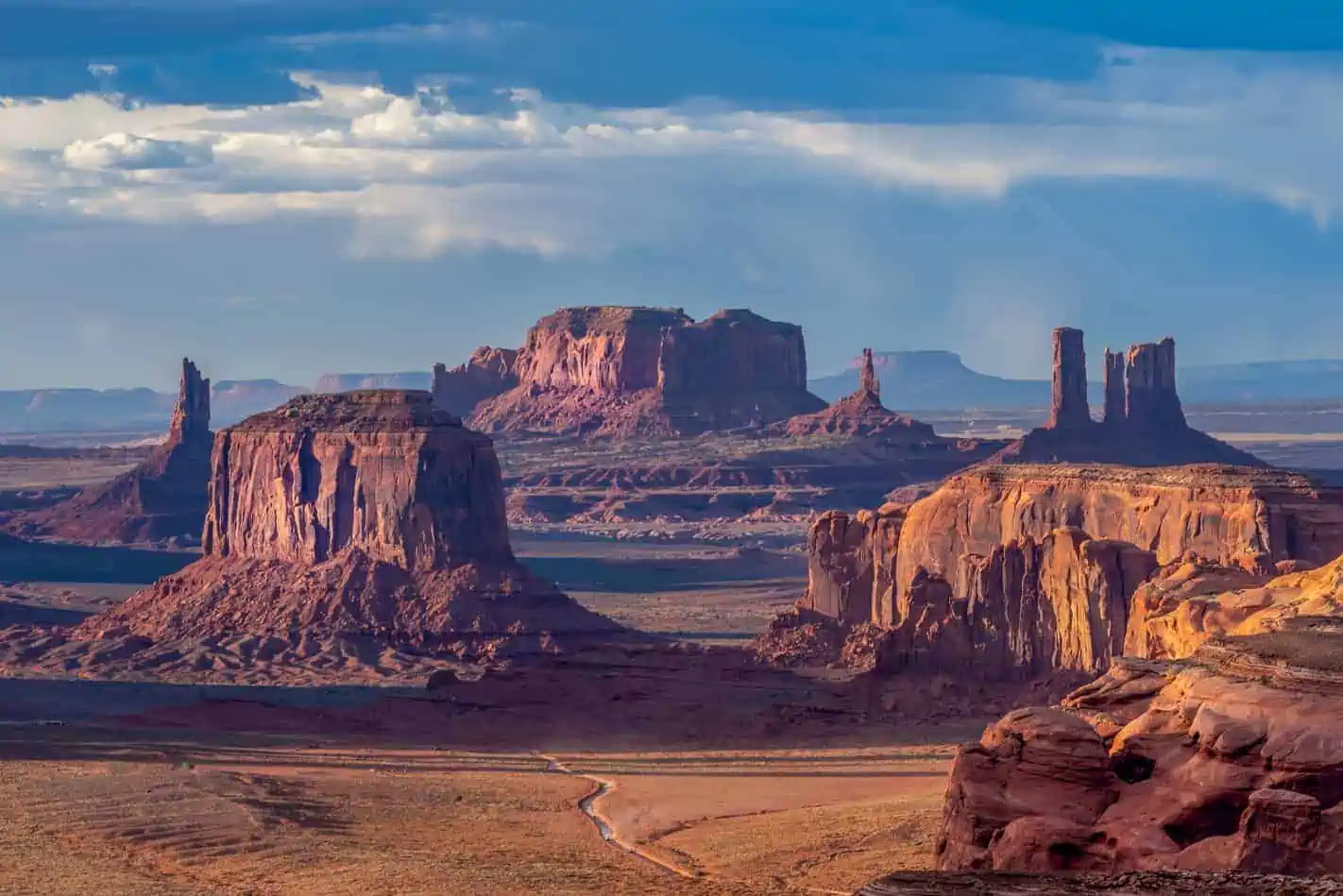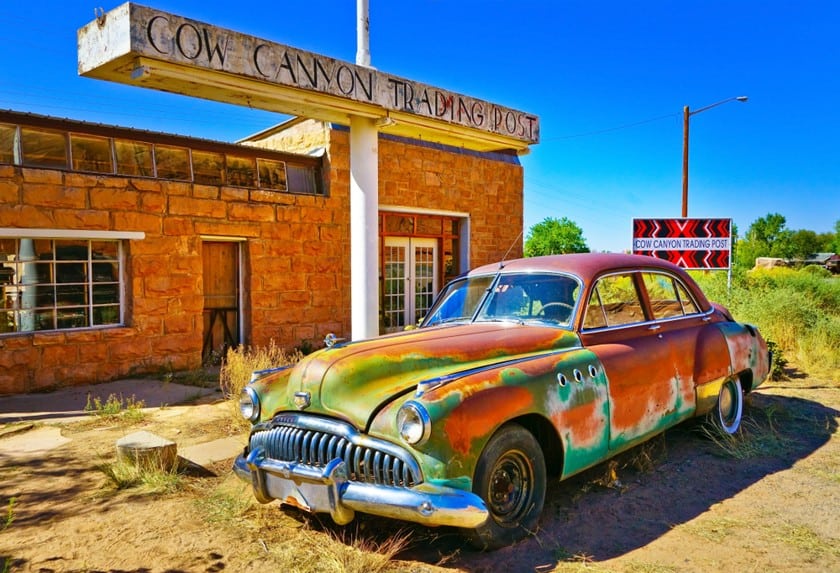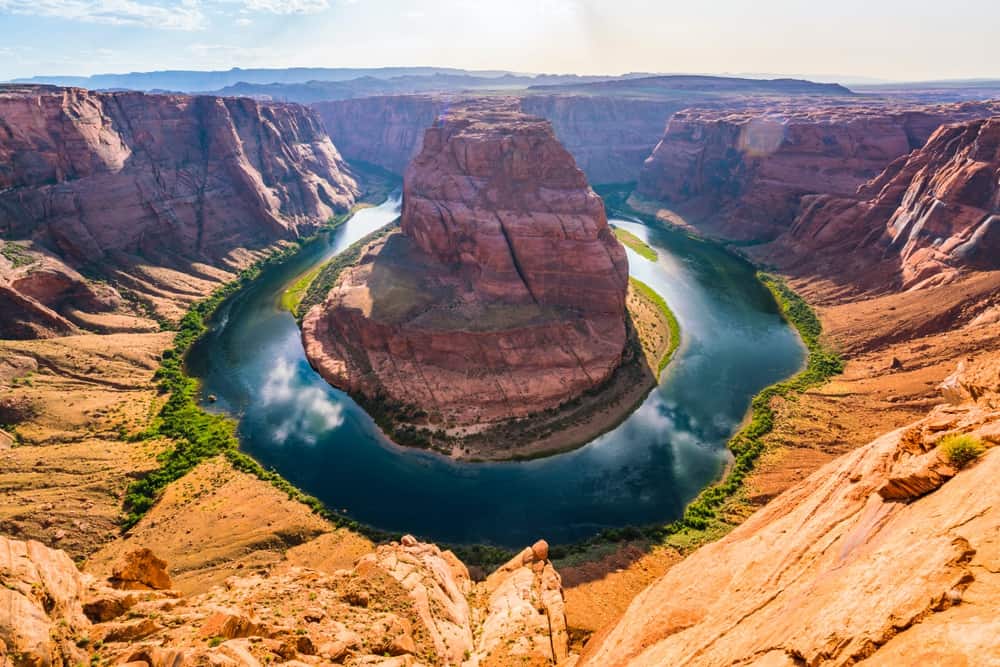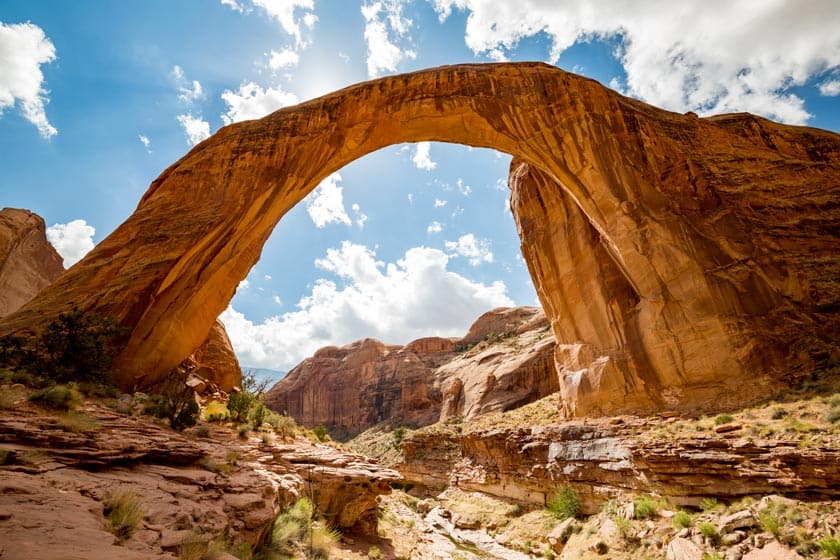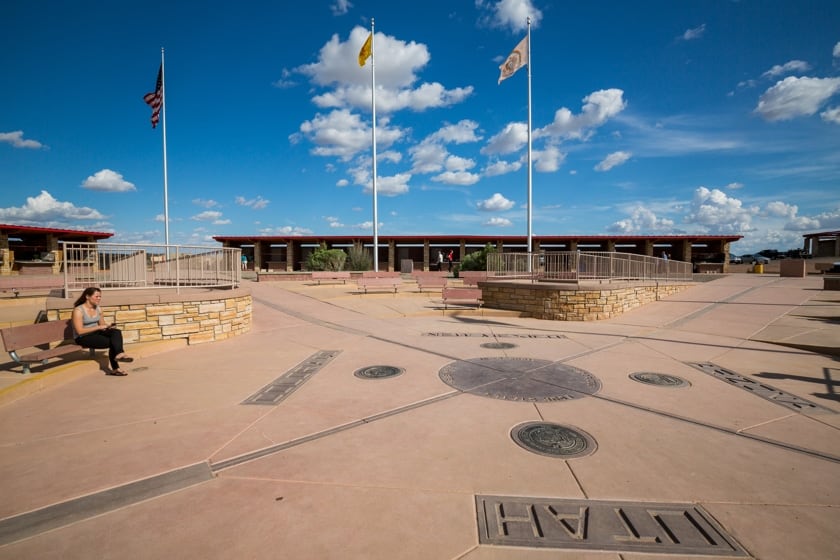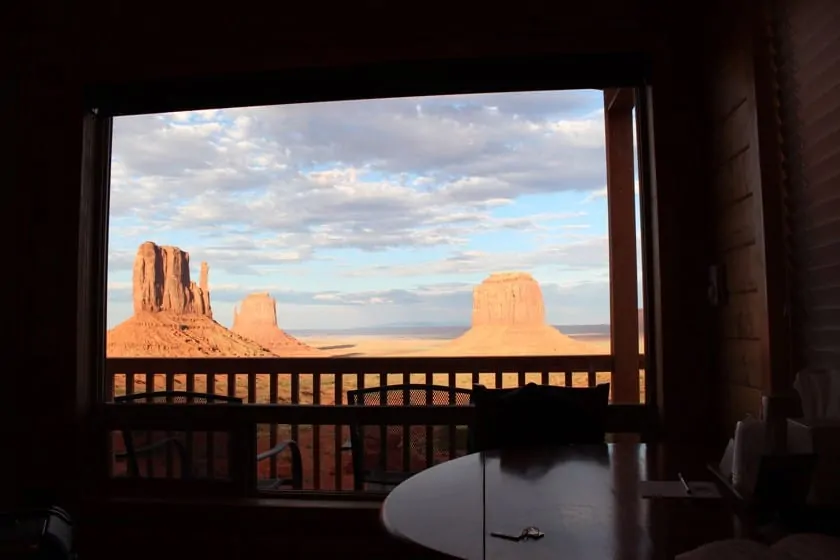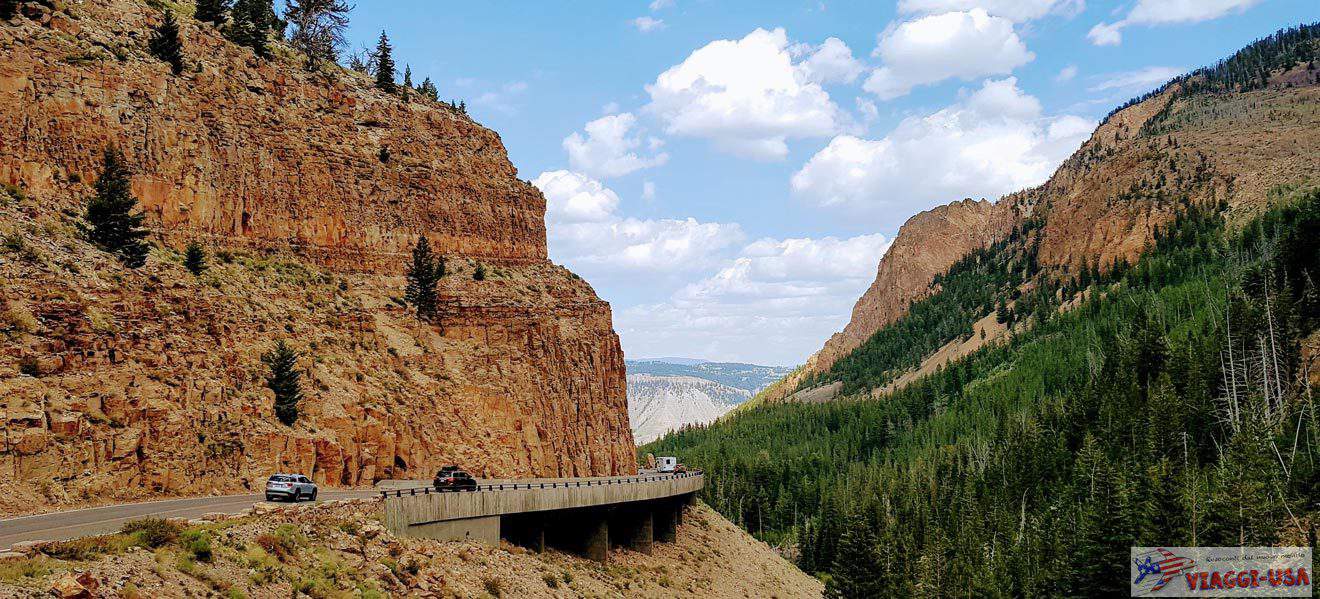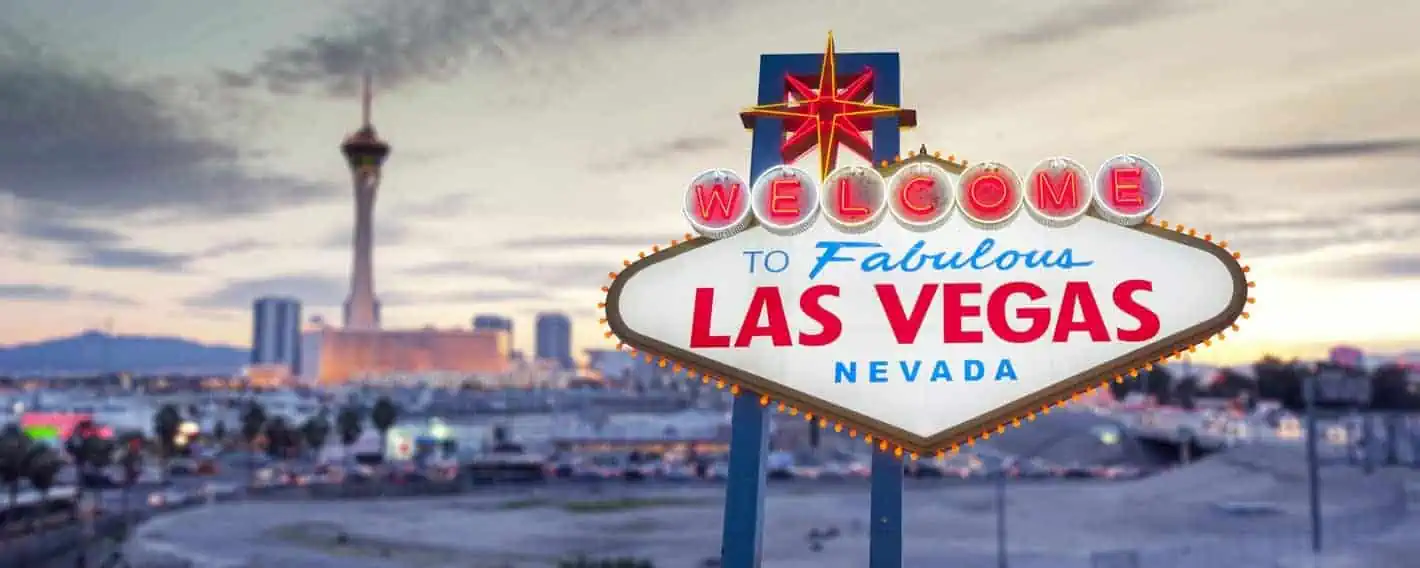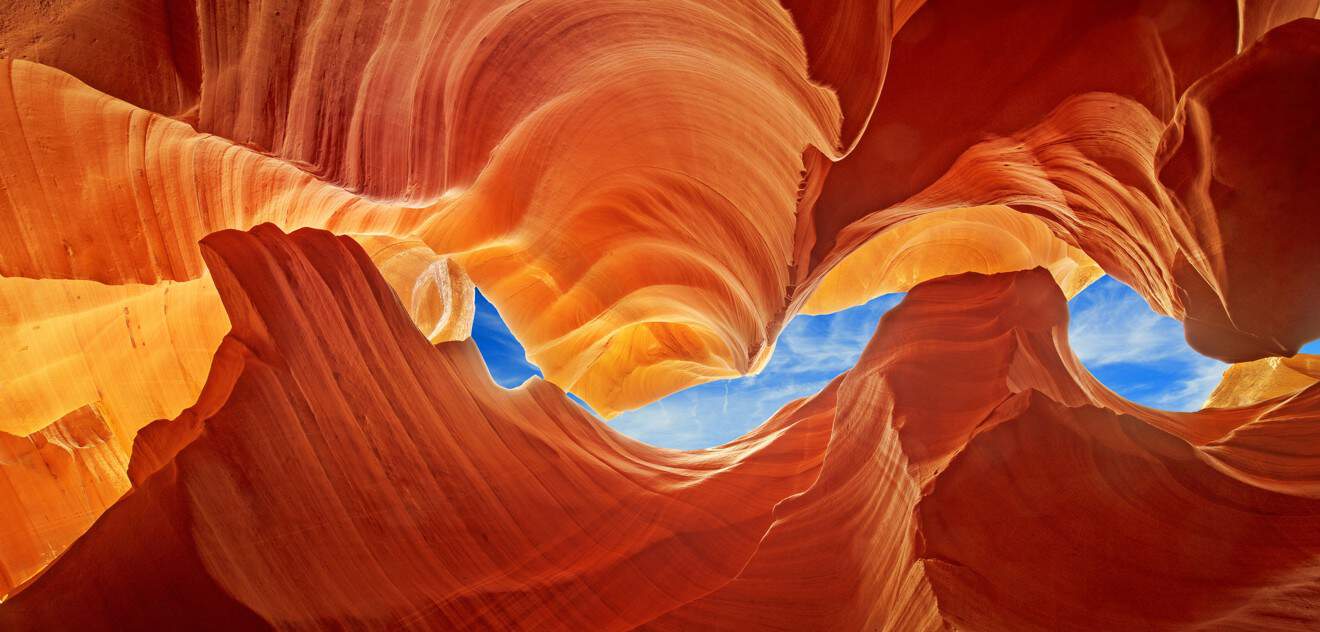What if we told you that some of the most symbolic photos of the United States, starting with the iconic Monument Valley, were not taken in any of the fifty states? In a sense, that would be correct, because there are also Indian reservations, and one of them is so large and complex that it almost could be considered a state in itself.
I am referring to the Navajo Nation, a 27,413 square-mile area that spans across Arizona, Utah, and New Mexico, larger than ten of the fifty American states. This vast land is home to some of America’s natural landmarks, and it is almost a must to visit it, or at least traverse part of it, on a trip to the Southwest!
Contents
As mentioned above, the Navajo Nation occupies part of Arizona, Utah, and New Mexico. When you look at the map, you will see that the boundaries of these three states, together with Colorado, form a perfect cross. This is, in fact, one of many American borders that seem to have been drawn with a pencil and ruler. The reservation is mostly in Arizona in the northeast corner of the state. It then spreads eastward into New Mexico and northward into a small portion of Utah.
The Navajo Nation does not extend into Colorado, however, so its boundaries are aligned with those of the states bordering Colorado. However, in Colorado, there are two other smaller Indian reservations, the Ute Mountain Reservation and the Southern Ute Indian Reservation. Thus, when considering all of the reservations together, it definitely gives you a more complete picture.
In addition to considering the main boundaries of the reservation, there are also two additional aspects to pay attention to. In New Mexico, the Navajo Nation also has a number of fairly large territories scattered around the main reservation. Traveling near Gallup or Crownpoint, it is likely that you will pass in and out of the Navajo Nation territories several times. Additionally, in northwestern New Mexico, we find smaller reservations, such as the Zuni Indian Reservation and the Ramah Navajo Indian Reservation.
Secondly, in the part of the reservation located in Arizona, there is a separate entity within the Navajo Nation, the Hopi Reservation, which is entirely surrounded by the Navajo Nation. Therefore, when traveling along AZ-264, one will cross a reservation within a reservation.
When visiting the Navajo Nation, you will have access to some of America’s most famous and symbolic natural monuments. As we have already mentioned in other articles, it is good to keep certain factors in mind when traveling across multiple states (read about it in our section on on-the-road travel), and this is even more true when entering a reservation, which has some different regulations, including time zones and access to the parks via organized tours.
When is the best time to go? Climate and time zones
The first aspect to keep in mind when traveling in these parts is climate. Although these areas can be visited roughly year-round, not all periods are ideal weather-wise, considering that this is an arid area far from the ocean. The information we provided in an article about the climate in Monument Valley, applies to the rest of the Navajo Nation and can help you figure out which months you might prefer to visit this area.
There is, however, another crucial factor to keep in mind: the time zone. Here things start to get tricky and it is good to be careful so as not to have unwelcome surprises, such as arriving late to a guided tour because you have not moved the hands on the clock correctly. Let’s start with the fact that the contiguous United States (to be clear, all of the states excluding Alaska and Hawaii) is divided into four time zones: Pacific Time, Mountain Time, Central Time, and Eastern Time. The time zone of the Navajo Nation should be easy to figure out considering that all the states it traverses are on Mountain Time.
However, a critical issue arises during certain months of the year, because Arizona is the only state that does not use Daylight Savings Time, and the Hopi Reservation (located within the Navajo Nation) also follows this. Instead, the Navajo Nation regularly adopts Daylight Savings Time, in line with the other surrounding states. One can therefore find oneself, moving in and out of this territory, moving the hands of the clock several times even throughout the course of a day. To get a clearer idea of how the time zones work, check out our article on the time zones in Arizona Utah, and Indian Reservations.
The territory occupied by the Navajo Nation is a concentration of natural wonders, some of which are among the must-sees on any trip to the American Southwest. We have devoted entire articles to most of these places, so we recommend that you delve into those of interest to you.
Natural wonders in Arizona
- Monument Valley. It is one of the most iconic places in the entire United States, capable of captivating even those who return time and time again. It has served as the backdrop for countless Westerns-just think of John Ford’s Point– but it is also seen in films such as Forrest Gump and, of course, has inspired the Warner Bros. Wile E. Coyote cartoon.
- Navajo National Monument. Not far from Monument Valley, this park is a treasure trove of important historical evidence. In addition to the hiking trails, it is worth a visit to learn more about Navajo history.
- Canyon de Chelly National Monument. Another place that combines natural beauty with historical evidence. Definitely worth adding to your list.
- Antelope Canyon. Who wouldn’t recognize the picture of the narrow, winding red rock canyon? Located near Page, this is an essential stop on a road trip to Arizona.
- Horseshoe Bend. Also a stone’s throw from Page, Horseshoe Bend is another unmistakable postcard image. This is the most famous bend in the Colorado River.
- Grand Falls. Also known as Chocolate Falls, these striking waterfalls (taller even than the famous Niagara Falls) owe their nickname to the color of the muddy water that billows into the canyon at certain times of the year.
- Little Colorado River Navajo Tribal Park: This little miniature Grand Canyon is located right on the doorstep of its much more famous counterpart and you will have the chance to enjoy its 2 viewpoints in complete solitude.
- Window Rock. Located near the New Mexico border, Window Rock is a fascinating stop on a trip between New Mexico and Arizona.
- White Mesa Arch (Tonalea). White Mesa Arch stunning arch more than 25 feet high and 16 feet wide with a distinctive elongated shape. It is a gorgeous rock formation located in a remote area, as is Margaret Arch, another spectacular natural arch nearby.
- Dinosaur Tracks: Not far from Tuba City is this site where you can see traces of theropods from the Lower Jurassic period.
Natural wonders in Utah
- Lake Powell. Although the main access to Lake Powell is near Glen Canyon Dam in Arizona, most of this spectacular man-made lake is in Utah. The southern shoreline of the lake is in the Navajo Nation.
- Rainbow Bridge National Monument. It may be less famous than other arches in Arches National Park or Natural Bridges National Monument, nevertheless, this splendid arch rivals its peers.
Natural wonders in New Mexico
- Shiprock. Believed to be magical according to the Navajo and an ideal backdrop for science fiction films, this rock formation is one of the most striking natural attractions in New Mexico.
- Bisti/De-Na-Zin Wilderness. Do you like bizarre-shaped rocks? Here’s another must-see stop on your trip.
- Church Rock. A rock that looks like a cathedral? That’s also waiting for you on the route between Monument Valley and Grand Canyon.
- Chaco Canyon. Chaco Canyon is home to some ancient Pueblos.
Four Corners
We have already talked about the cross-shaped border of Utah, Arizona, New Mexico, and Colorado, and right at the point where these states meet, there is the Four Corners Monument Navajo Tribal Park, which will give you a chance to put one foot in four states at once. For more information on how to visit it, read our article on Four Corners Monument.
To cross the Navajo Nation by car is certainly feasible. However, to access some parks it is recommended, or sometimes even mandatory, to go on organized tours. Tourism is the main source of income for many of the Navajo living on the reservation, so it is understandable that visitors are required to rely on a local guide.
One of the best examples is Antelope Canyon, where reservations are mandatory, and in the high season, it is really difficult to access it without having booked tickets in advance. In the article about this particular slot canyon, we have gone over all the details. Another park where you might consider a tour (although it is not mandatory) is Monument Valley so that you can make the most out of the experience and see more. Again, you can find descriptions of the various tours in our article Monument Valley Tours.
Trading posts
When visiting the Navajo Nation, it is very common for visitors to stop at the trading posts: Old West style outlets where you can buy just about anything from everyday goods to rugs to a long list of souvenirs. There are 10 trading posts recognized by the Navajo Tourism Department that are scattered throughout the reservation.
They all date from the late 1800s or early 1900s, but the oldest trading post appears to be the one in Toadlena, New Mexico. Active since 1870, this trading post specializes in textiles. However, the one located on most tourist routes is the one in Tuba City, Arizona, the town on the way from Monument Valley to the Grand Canyon or vice versa. Here is a list of all the trading posts.
- The Gap Trading Post, P.O. Box 1480, Gap, Arizona 86020. Directions
- Tuba City Trading Post, 10 N. Main Street, Tuba City, Arizona 86045. Directions
- Toadlena Trading Post, P.O. Box 8041, Newcomb, New Mexico 87455. Directions
- Totsoh Trading Post, P.O. Box 218, Lukachukai, Arizona 86507. Directions
- Hubbell Trading Post National Historic Site, P.O. Box 150, Ganado, Arizona 86505. Directions
- Foutz Trading Post, Highway 64, Shiprock, New Mexico 87420. Directions
- Teec Nos Pos Trading Post, Box 940, Intersection Highway 160 & 64, Teec Nos Pos, Arizona 86514. Directions
- Inscription House Trading Post, 5300 Bahajooba Way, Tonalea, Arizona 86044. Directions
- Two Grey Hills Trading Post, HCR330, Box 70, Tohatchi, New Mexico. Directions
- Oljato Trading Post, Oljato Chapter House, Utah. Directions
Going to the Navajo Nation is a must to visit some of the major natural wonders in the United States. Because it is so extensive, you can access it from multiple directions, and if you are planning a road trip you ought to consider making one or more stops in the Navajo Nation. Here is how to get there from different directions.
- From Arizona. As the state where most of the reservation is located, there is more than one road to get there. Flagstaff is the main city in the area and is near the southwestern border of the reservation, but it is also at the junction of I-17 (which runs down from Flagstaff to Phoenix) and the famous Route 66, which crosses the reservation from east to west. US-89 begins in Flagstaff, crosses part of the reservation, and passes through Page before continuing into Utah. Then there is also AZ-64, which connects the reservation to the Grand Canyon.
- From Utah. If you are coming from the north, there are two alternatives. The first is US-89, which enters Arizona near Glen Canyon Dam, passes through Page, and then enters the reservation. Considering that the reservation boundary skirts the very long and jagged Lake Powell, one has to get to Mexican Hat from another main entrance to the Navajo Nation. This is US-163, which leads to none other than Monument Valley.
- From New Mexico. If you are coming from the southeast there are two main alternatives: US-64, which enters the reservation near Shiprock, and US-491, which runs south to north through this part of the Navajo Nation.
- From Colorado. Coming from Colorado the main alternative is the aforementioned US-491, which crosses the border and enters New Mexico and, consequently, the Navajo Nation.
As I have already mentioned, there is also another smaller Indian reservation within the Navajo Nation that has its own jurisdiction as well as a different tribe living there. It spans over 2,500 square miles, so if you drive through the Navajo Nation you are likely to find yourself going in and out of this smaller reservation as well. This is not something to overlook, especially because of the time zone issue, which we addressed earlier in the article.
AZ-264 cuts across the Hopi Reservation. The other major route through it is AZ-87, which runs south starting from Second Mesa (in the center of the reservation) until it connects with Route 66. If you travel between the more famous attractions you will only skirt it, but you will have to enter it if you want to see more special places such as the Coal Mine Canyon.
Many people choose to spend at least one night in the Navajo Nation during their trip. There are several options, but some are better logistically for visiting major points of interest. Looking at the cities, or rather towns, that we find on the reservation, a good option near Tuba City is the Navajoland Hotel, a quiet place suitable for a road trip.
In Kayenta, I recommend the Hampton Inn, a three-star hotel, or the Wetherill Inn, a two-star hotel. Undoubtedly, it would be an excellent choice to spend the night at Monument Valley, where there are some accommodations that are ideal if you plan to visit the park starting early in the morning or if you want to stay there until after sunset. To learn more you can read our tips on where to stay in Monument Valley. As for overnight stays near other parks in the Navajo Nation, you will find detailed advice in our other articles. The links to these articles can be found on this page.
